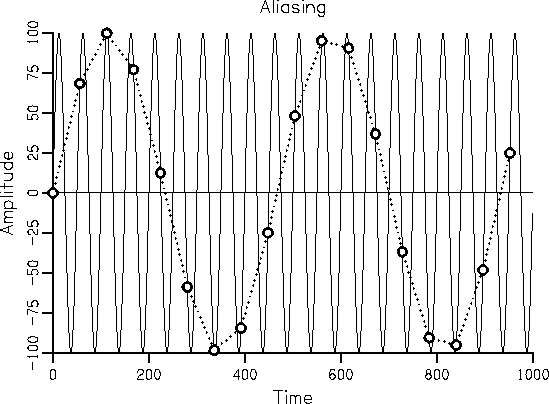Sampling Rate
Sampling rate determines the sound frequency range (corresponding to
pitch) which can be represented in the digital waveform. The range of
frequencies represented in a waveform is often called its
bandwidth. Waveforms sampled at a high sampling rate can
represent a broad range of frequencies and hence have broad
bandwidth. In fact, the maximum bandwidth of a sampled waveform is
determined exactly by its sampling rate; the maximum frequency
representable in a sampled waveform is termed its Nyquist
frequency, and is equal to one half the sampling rate. Thus, for
example, a waveform sampled at 16,000 Hz can represent all frequencies
up to its Nyquist frequency of 8,000 Hz.
A problem called aliasing occurs when a signal to be
sampled contains energy at frequencies above the sampling Nyquist
frequency. The next figure illustrates how aliasing would occur when
the sampling rate is much too low for the frequency of an input
signal. The solid curve represents the analog signal at a
comparatively high frequency. Circles show where samples were taken at
a relatively low sampling rate. The dotted line illustrates the
apparent frequency of the sampled waveform, completing about two
cycles in the period that the original signal completed 20 cycles.

Obviously, aliasing has the effect of producing sounds of lower
frequency from sounds that are higher in frequency than the Nyquist
frequency. Once aliasing has occurred, it is absolutely impossible to
distinguish a component generated by aliasing from one that was
actually present in the input signal. This effect is one of the most
common sources of distortion in digitized waveforms. Fortunately, most
modern computer hardware for digitizing sound has builtin filters
which are tuned to remove sound energy at frequencies beyond the
Nyquist frequency for whatever sampling rate is being used.
